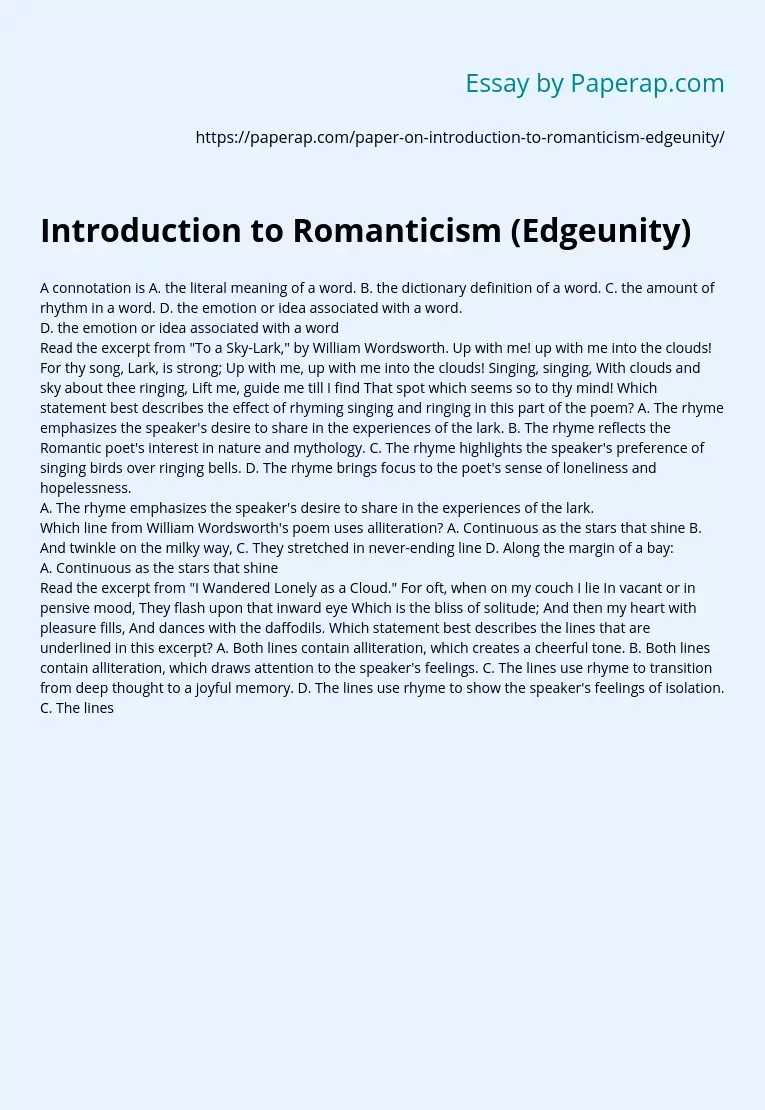Introduction to Romanticism (Edgeunity)
A. the literal meaning of a word.
B. the dictionary definition of a word.
C. the amount of rhythm in a word.
D. the emotion or idea associated with a word.
Up with me! up with me into the clouds!
For thy song, Lark, is strong;
Up with me, up with me into the clouds!
Singing, singing,
With clouds and sky about thee ringing,
Lift me, guide me till I find
That spot which seems so to thy mind!
Which statement best describes the effect of rhyming singing and ringing in this part of the poem?
A. The rhyme emphasizes the speaker’s desire to share in the experiences of the lark.
B. The rhyme reflects the Romantic poet’s interest in nature and mythology.
C. The rhyme highlights the speaker’s preference of singing birds over ringing bells.
D. The rhyme brings focus to the poet’s sense of loneliness and hopelessness.
A. Continuous as the stars that shine
B. And twinkle on the milky way,
C. They stretched in never-ending line
D. Along the margin of a bay:
For oft, when on my couch I lie
In vacant or in pensive mood,
They flash upon that inward eye
Which is the bliss of solitude;
And then my heart with pleasure fills,
And dances with the daffodils.
Which statement best describes the lines that are underlined in this excerpt?
A. Both lines contain alliteration, which creates a cheerful tone.
B. Both lines contain alliteration, which draws attention to the speaker’s feelings.
C. The lines use rhyme to transition from deep thought to a joyful memory.
D. The lines use rhyme to show the speaker’s feelings of isolation.
A. an interest in innovation.
B. the use of self-control.
C. an emphasis on order.
D. the use of imagination.
A. create rhythm and emphasize ideas.
B. highlight scientific facts and findings.
C. argue in a logical, structured manner.
D. show readers a rational new idea.
A. draw inspiration from the natural world.
B. discuss scientific laws governing nature.
C. show people’s logical place in the universe.
D. suggest the importance of new inventions.
When all at once I saw a crowd,
A host, of golden daffodils;
Beside the lake, beneath the trees,
Fluttering and dancing in the breeze
This excerpt is an example of Romantic poetry because it
A.hints at how people should live.
B. uses everyday language.
C. studies nature logically.
D. is based on a folktale.
A. the physical world.
B. the uses of science.
C. the freedom of expression.
D. the value of self-control.
A. word choice.
B. author’s attitude.
C. repeated phrases.
D. feelings and ideas.
Introduction to Romanticism (Edgeunity). (2017, Dec 15). Retrieved from https://paperap.com/paper-on-introduction-to-romanticism-edgeunity/

